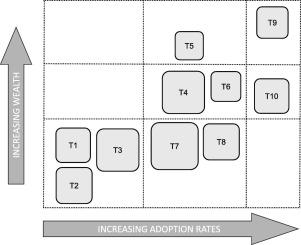当前位置:
X-MOL 学术
›
Agric. Syst.
›
论文详情
Our official English website, www.x-mol.net, welcomes your feedback! (Note: you will need to create a separate account there.)
Towards actionable farm typologies: Scaling adoption of agricultural inputs in Rwanda
Agricultural Systems ( IF 6.6 ) Pub Date : 2020-08-01 , DOI: 10.1016/j.agsy.2020.102857 Jim Hammond , Nathaniel Rosenblum , Dana Breseman , Léo Gorman , Rhys Manners , Mark T. van Wijk , Milindi Sibomana , Roseline Remans , Bernard Vanlauwe , Marc Schut
Agricultural Systems ( IF 6.6 ) Pub Date : 2020-08-01 , DOI: 10.1016/j.agsy.2020.102857 Jim Hammond , Nathaniel Rosenblum , Dana Breseman , Léo Gorman , Rhys Manners , Mark T. van Wijk , Milindi Sibomana , Roseline Remans , Bernard Vanlauwe , Marc Schut

|
Abstract Rollout of development interventions using a one-size-fits-all model can achieve economies of scale but neglects to account for variability in farm and farmer characteristics. A data-driven approach to incorporate farmer diversity in scaling strategies may help to achieve greater development impact. However, interpreting the multiplicity of smallholder characteristics is complex, time-consuming, and the ways in which the insights gained can be implemented is poorly understood. Navigating these tensions, we present a farm typology study carried out in collaboration with a large development organisation (the “scaling partner”) promoting agricultural inputs in Rwanda. This study was conducted late in the scaling pathway, in order to finesse the scaling strategy, rather than to target intervention selection. Drawing on nearly 3000 interviews from 17 districts of the Western, Southern, and Eastern Provinces of Rwanda, the typology differentiates households along two axes: 1. prosperity (a cornerstone of conventional typologies), and 2. adoption of inputs (fertilisers and improved crop varieties). We used an efficient household survey tool, a minimum-variable approach, and concepts from the study of adoption of agricultural innovations. Through an action-research collaboration with the scaling organisation we adapted the methods and the findings to be “actionable. Approximately two-thirds of the study population were using fertilisers and improved seed to some extent. Along each prosperity stratum, however, there were multiple degrees of adoption, demonstrating the value of including adoption information in typology constructions. Ten farm types were identified, where the key differences along the prosperity axis were land area cultivated and livestock owned, and the key differences along the adoption axis were perceptions of input efficacy, access to training, and education level. We also present a simple decision tree model to assign new households to a farm type. The findings were used in three ways by the scaling organisation: (i) characterisation of the population into discrete groups; (ii) prioritisation, of farm types for engagement, and geographical locations for further investment; and (iii) design of decision support tools or re-design of packages to support technology adoption for specific farm types. The need for field-level validation of the typologies was also stressed by the scaling organisation.
中文翻译:

走向可行的农场类型:在卢旺达扩大采用农业投入
摘要 使用一刀切模型推出发展干预措施可以实现规模经济,但忽略了农场和农民特征的可变性。将农民多样性纳入规模战略的数据驱动方法可能有助于实现更大的发展影响。然而,解释小农特征的多样性是复杂、耗时的,而且对所获得的见解可以实施的方式知之甚少。为了应对这些紧张局势,我们提出了一项与促进卢旺达农业投入的大型发展组织(“规模合作伙伴”)合作进行的农场类型研究。这项研究是在扩展路径的后期进行的,目的是完善扩展策略,而不是针对干预选择。根据来自卢旺达西部、南部和东部省份 17 个地区的近 3000 次访谈,该类型将家庭沿两个轴区分开来:1. 繁荣(传统类型学的基石),以及 2. 投入物的采用(化肥和改良作物)品种)。我们使用了有效的住户调查工具、最小变量方法和农业创新采用研究中的概念。通过与扩展组织的行动研究合作,我们将方法和结果调整为“可操作的”。大约三分之二的研究人群在一定程度上使用肥料和改良种子。然而,在每个繁荣层,都有多种采用程度,这表明在类型结构中包含采用信息的价值。确定了十种农场类型,繁荣轴上的主要差异是耕地面积和牲畜拥有量,采用轴上的主要差异是对投入效率、培训机会和教育水平的看法。我们还提供了一个简单的决策树模型来将新家庭分配到农场类型。缩放组织以三种方式使用这些发现:(i) 将人口表征为离散的群体;(ii) 优先参与的农场类型和进一步投资的地理位置;(iii) 设计决策支持工具或重新设计软件包以支持特定农场类型的技术采用。规模化组织也强调了对类型学进行现场级验证的必要性。其中繁荣轴上的主要差异是耕地面积和牲畜拥有量,采用轴上的主要差异是对投入效率、培训机会和教育水平的看法。我们还提供了一个简单的决策树模型来将新家庭分配到农场类型。缩放组织以三种方式使用这些发现:(i) 将人口表征为离散的群体;(ii) 优先参与的农场类型和进一步投资的地理位置;(iii) 设计决策支持工具或重新设计软件包以支持特定农场类型的技术采用。规模化组织也强调了对类型学进行现场级验证的必要性。其中繁荣轴上的主要差异是耕地面积和牲畜拥有量,采用轴上的主要差异是对投入效率、培训机会和教育水平的看法。我们还提供了一个简单的决策树模型来将新家庭分配到农场类型。缩放组织以三种方式使用这些发现:(i) 将人口表征为离散的群体;(ii) 优先参与的农场类型和进一步投资的地理位置;(iii) 设计决策支持工具或重新设计软件包以支持特定农场类型的技术采用。规模化组织也强调了对类型学进行现场级验证的必要性。沿采用轴的主要差异是对投入效率、获得培训的机会和教育水平的看法。我们还提供了一个简单的决策树模型来将新家庭分配到农场类型。缩放组织以三种方式使用这些发现:(i) 将人口表征为离散的群体;(ii) 优先参与的农场类型和进一步投资的地理位置;(iii) 设计决策支持工具或重新设计软件包以支持特定农场类型的技术采用。规模化组织也强调了对类型学进行现场级验证的必要性。沿采用轴的主要差异是对投入效率、获得培训的机会和教育水平的看法。我们还提供了一个简单的决策树模型来将新家庭分配到农场类型。缩放组织以三种方式使用这些发现:(i) 将人口表征为离散的群体;(ii) 优先参与的农场类型和进一步投资的地理位置;(iii) 设计决策支持工具或重新设计软件包以支持特定农场类型的技术采用。规模化组织也强调了对类型学进行现场级验证的必要性。缩放组织以三种方式使用这些发现:(i) 将人口表征为离散的群体;(ii) 优先参与的农场类型和进一步投资的地理位置;(iii) 设计决策支持工具或重新设计软件包以支持特定农场类型的技术采用。规模化组织也强调了对类型学进行现场级验证的必要性。缩放组织以三种方式使用这些发现:(i) 将人口表征为离散的群体;(ii) 优先参与的农场类型和进一步投资的地理位置;(iii) 设计决策支持工具或重新设计软件包以支持特定农场类型的技术采用。规模化组织也强调了对类型学进行现场级验证的必要性。
更新日期:2020-08-01
中文翻译:

走向可行的农场类型:在卢旺达扩大采用农业投入
摘要 使用一刀切模型推出发展干预措施可以实现规模经济,但忽略了农场和农民特征的可变性。将农民多样性纳入规模战略的数据驱动方法可能有助于实现更大的发展影响。然而,解释小农特征的多样性是复杂、耗时的,而且对所获得的见解可以实施的方式知之甚少。为了应对这些紧张局势,我们提出了一项与促进卢旺达农业投入的大型发展组织(“规模合作伙伴”)合作进行的农场类型研究。这项研究是在扩展路径的后期进行的,目的是完善扩展策略,而不是针对干预选择。根据来自卢旺达西部、南部和东部省份 17 个地区的近 3000 次访谈,该类型将家庭沿两个轴区分开来:1. 繁荣(传统类型学的基石),以及 2. 投入物的采用(化肥和改良作物)品种)。我们使用了有效的住户调查工具、最小变量方法和农业创新采用研究中的概念。通过与扩展组织的行动研究合作,我们将方法和结果调整为“可操作的”。大约三分之二的研究人群在一定程度上使用肥料和改良种子。然而,在每个繁荣层,都有多种采用程度,这表明在类型结构中包含采用信息的价值。确定了十种农场类型,繁荣轴上的主要差异是耕地面积和牲畜拥有量,采用轴上的主要差异是对投入效率、培训机会和教育水平的看法。我们还提供了一个简单的决策树模型来将新家庭分配到农场类型。缩放组织以三种方式使用这些发现:(i) 将人口表征为离散的群体;(ii) 优先参与的农场类型和进一步投资的地理位置;(iii) 设计决策支持工具或重新设计软件包以支持特定农场类型的技术采用。规模化组织也强调了对类型学进行现场级验证的必要性。其中繁荣轴上的主要差异是耕地面积和牲畜拥有量,采用轴上的主要差异是对投入效率、培训机会和教育水平的看法。我们还提供了一个简单的决策树模型来将新家庭分配到农场类型。缩放组织以三种方式使用这些发现:(i) 将人口表征为离散的群体;(ii) 优先参与的农场类型和进一步投资的地理位置;(iii) 设计决策支持工具或重新设计软件包以支持特定农场类型的技术采用。规模化组织也强调了对类型学进行现场级验证的必要性。其中繁荣轴上的主要差异是耕地面积和牲畜拥有量,采用轴上的主要差异是对投入效率、培训机会和教育水平的看法。我们还提供了一个简单的决策树模型来将新家庭分配到农场类型。缩放组织以三种方式使用这些发现:(i) 将人口表征为离散的群体;(ii) 优先参与的农场类型和进一步投资的地理位置;(iii) 设计决策支持工具或重新设计软件包以支持特定农场类型的技术采用。规模化组织也强调了对类型学进行现场级验证的必要性。沿采用轴的主要差异是对投入效率、获得培训的机会和教育水平的看法。我们还提供了一个简单的决策树模型来将新家庭分配到农场类型。缩放组织以三种方式使用这些发现:(i) 将人口表征为离散的群体;(ii) 优先参与的农场类型和进一步投资的地理位置;(iii) 设计决策支持工具或重新设计软件包以支持特定农场类型的技术采用。规模化组织也强调了对类型学进行现场级验证的必要性。沿采用轴的主要差异是对投入效率、获得培训的机会和教育水平的看法。我们还提供了一个简单的决策树模型来将新家庭分配到农场类型。缩放组织以三种方式使用这些发现:(i) 将人口表征为离散的群体;(ii) 优先参与的农场类型和进一步投资的地理位置;(iii) 设计决策支持工具或重新设计软件包以支持特定农场类型的技术采用。规模化组织也强调了对类型学进行现场级验证的必要性。缩放组织以三种方式使用这些发现:(i) 将人口表征为离散的群体;(ii) 优先参与的农场类型和进一步投资的地理位置;(iii) 设计决策支持工具或重新设计软件包以支持特定农场类型的技术采用。规模化组织也强调了对类型学进行现场级验证的必要性。缩放组织以三种方式使用这些发现:(i) 将人口表征为离散的群体;(ii) 优先参与的农场类型和进一步投资的地理位置;(iii) 设计决策支持工具或重新设计软件包以支持特定农场类型的技术采用。规模化组织也强调了对类型学进行现场级验证的必要性。



























 京公网安备 11010802027423号
京公网安备 11010802027423号